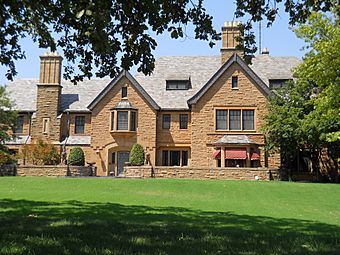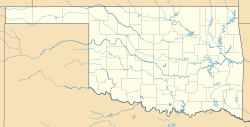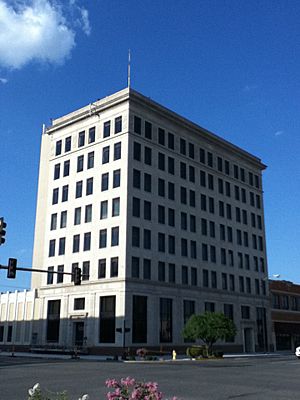H. H. Champlin House facts for kids
Quick facts for kids |
|
|
H.H. Champlin House
|
|
 |
|
| Location | 612 S. Tyler, Enid, Oklahoma |
|---|---|
| Area | 3 acres (1.2 ha) |
| Built | 1939 |
| Architect | Roy Shaw, Norris Wheeler, D.C. Bass |
| Architectural style | Tudor Revival |
| NRHP reference No. | 92001833 |
| Added to NRHP | January 21, 1993 |
The H.H. Champlin House is a large, two-and-a-half-story building made of sandstone. It was built in the Tudor Revival style, which looks like old English homes. This historic house was finished in 1939. You can find it at 612 S. Tyler in Enid, Oklahoma. It sits in an area called Kisner Heights, which used to be farmland.
Architects Roy Shaw and Norris Wheeler designed the house. The D.C. Bass Company built the main house. Its walls are made of Briar Hill sandstone. The roof and outdoor terrace use Vermont slate. Special windows were custom-made for the house. Art glass was added to the Tudor arch windows. These glass pieces show scenes from Oklahoma's history. The property also has a carport and a greenhouse.
Who Was H.H. Champlin?
Herbert Hiram Champlin was born on February 18, 1868, in Winnebago County, Illinois. He was the oldest of six brothers. His family moved to McPherson County, Kansas. H.H. Champlin finished McPherson High School. He also went to Friends University and Hill's Business College. He married Ary Delight Noble in 1895, and they had four children. Herbert H. Champlin passed away on April 30, 1944.
The First National Bank of Enid
H.H. Champlin took part in the land run of 1893. He invested in the Enid State Guaranty Bank. Later, he bought a lumber yard. He then bought back the bank he had invested in.
In March 1933, many banks were closing across the country. Oklahoma's Governor, William H. Murray, ordered all banks in the state to close. But Champlin refused to close his bank. He believed it was financially strong. Because of this, the governor sent the National Guard. Captain Stephen J. England led 18 soldiers to close the bank. This made the First National Bank of Enid the only bank in American history ever closed by the military! Even though it survived the Great Depression, the bank closed in the 1980s. This happened because of a tough economy.
Champlin Oil Company
In 1916, oil was found at Garber Field. H.H. Champlin bought the rights to the oil from a farmer named George Beggs. His wife, Ary, encouraged him to do this. He bought a small oil refinery and built a pipeline to connect it to Garber Field.
In 1920, he bought the Goodwell Oil Company. This company had several places that sold oil in large amounts and many gas stations. During his life, the Champlin Oil Company grew a lot. It had gas stations and wholesale stores in 20 states in the Midwest. It also drilled for oil in Oklahoma, Texas, Colorado, and New Mexico. By the time Mr. Champlin died in 1944, his company employed over 800 people in Enid.
After his family owned it for nine more years, the company became public in 1953. This means anyone could buy shares in it.
The company had several owners over the years:
- 1954: The Chicago Corporation bought it for $55 million. This company later changed its name to Champlin Refining Company.
- 1964: The Celanese Company bought Champlin.
- 1970: It was sold to Union Pacific Corporation. It became a fully owned part of that company.
- 1984: The gas station part of Champlin was bought by American Petrofina. This happened after Champlin closed its refinery.
- Around 1986: Union Pacific Corporation sold the Corpus Christi Refinery. The Champlin name was part of this deal. Champlin's name then changed to Union Pacific Resources Company (UPRC).
- Late 1990s: Union Pacific Corporation separated from Union Pacific Resources Company.
- 2000: Anadarko Petroleum took over Union Pacific Resources.




